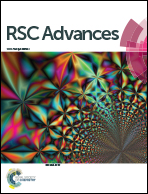Free energy landscapes of the encapsulation mechanism of DNA nucleobases onto carbon nanotubes†
Abstract
The confinement mechanism of DNA nucleobases onto single-walled carbon nanotubes is probed at physiological temperature (310 K) using classical molecular dynamics and fully atomistic molecular potentials. The corresponding free energy landscapes are constructed in terms of two order parameters, ξ1 and ξ2, for both purine (adenine) and pyrimidine (thymine) moieties, by a metadynamics scheme. Two zig-zag topologies, (16, 0) and (23, 0), are employed as solid models with limiting skeletal diameters, D = 1.25 nm and D = 1.8 nm, respectively, considering hydrophobic and electrically charged nanopores, q = +0.05 e−/C. The uncharged nanotubes always exhibit a single free energy minimum located close to the pore center, regardless of individual diameter, whereas the charged nanotubes either inhibit encapsulation or exhibit two energetically distinct confining regions, at the center and close to the pore termini. Very interestingly, the purely hydrophobic solids exhibit a quasi-isotropic free-energy landscape around the nanopore center, F (ξ1, ξ2). Independent umbrella sampling calculations show that for the (23, 0) electrically charged nanotubes, the probability maximum at a distance of Ω = 0.54 nm from the pore center is the global one for adenine. These subtle differences are quantified by decomposing the interaction energy between a nucleobase and the solid into its dispersive and electrostatic contributions, and a critical comparison with DFT and experimental data for graphite is discussed. Purine and pyrimidine show similar interaction energies within the hydrophobic nanopores, however, adenine confinement results in slightly more stable hybrids by 0.9–1.4 kJ mol−1; binding affinity increases with the nanotube curvature as a result of enhanced dispersive energy. The detailed thermodynamical analysis reported herein is of paramount importance to study the sequence specific properties of DNA/carbon nanotube hybrids.


 Please wait while we load your content...
Please wait while we load your content...